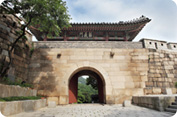World Heritage
Tentative List
- Kangjingun Kiln Sites (1994)
- Mt.Soraksan Nature Reserve (1994)
- Sites of fossilized dinosaurs throughout the Southern seacoast (2002)
- Salterns (2010)
- Southwestern Coast Tidal Flats (2010)
- Daegokcheon Stream Petroglyphs (2010)
- Ancient Mountain Fortresses in Central Korea (2010)
- Oeam Village (2011)
- Naganeupseong, Town Fortress and Village (2011)
- Upo Wetland (2011)
- Seoul City Wall (2012)
- Stone Buddhas and Pagodas at Hwasun Unjusa Temple(2017)
- Gaya Tumuli (2019)
 The Seoul City Wall surrounds Hanyang (now Seoul), formerly the capital of the Joseon Dynasty (1392-1910). King Taejo, the founder of Joseon, designated Hanyang as
the capital of the newly established dynasty in 1394. At his behest, the following buildings were constructed in 1395 : Royal Palace; Jongmyo Shrine; and Sajikdan Altar. The Seoul City Wall was built for more efficient operation and the
defense of the newly designated capital. The first portion of the work was finished in 1396. For more efficient management of the capital, the area within the walls was distinguished from the areas lying outside them. To reinforce the
defense of the capital, Bukhansanseong Fortress was built to the north of the Wall and Namhansanseong Fortress to the south of the Han River in the 17th century.
The Seoul City Wall surrounds Hanyang (now Seoul), formerly the capital of the Joseon Dynasty (1392-1910). King Taejo, the founder of Joseon, designated Hanyang as
the capital of the newly established dynasty in 1394. At his behest, the following buildings were constructed in 1395 : Royal Palace; Jongmyo Shrine; and Sajikdan Altar. The Seoul City Wall was built for more efficient operation and the
defense of the newly designated capital. The first portion of the work was finished in 1396. For more efficient management of the capital, the area within the walls was distinguished from the areas lying outside them. To reinforce the
defense of the capital, Bukhansanseong Fortress was built to the north of the Wall and Namhansanseong Fortress to the south of the Han River in the 17th century.
The 18.627 km-long Seoul City Wall was built along the ridge of Seoul???s four inner mountains (i.e., Baegaksan, Naksan, Namsan, and Inwangsan). At present, a 12-km section (563,882m2) of the wall is designated as Historic Site No. 10 (1963) and is protected accordingly, along with the gates, water gates, and signal fire mounds.
The location of the Seoul City Wall was determined based upon an understanding of the topography of the entire Korean Peninsula. The City Wall is located in a place where Baekdu-daegan (the chain of mountains forming the backbone of the Korean Peninsula) meets the streams that flow into the Han River. The City Wall has considerable value as a stone structure that marries the local topography well, as well as embodying the skills of builders and the labor of the many people who took part in their construction and repair throughout the Joseon Dynasty. It surrounds the capital, in which many historic architectures including Royal Palaces, Jongmyo Shrine and Sajikdan Altar are located, while being in a position that clearly displays the contours of the four inner mountains and both the inside and the outside of the capital.



 >
>